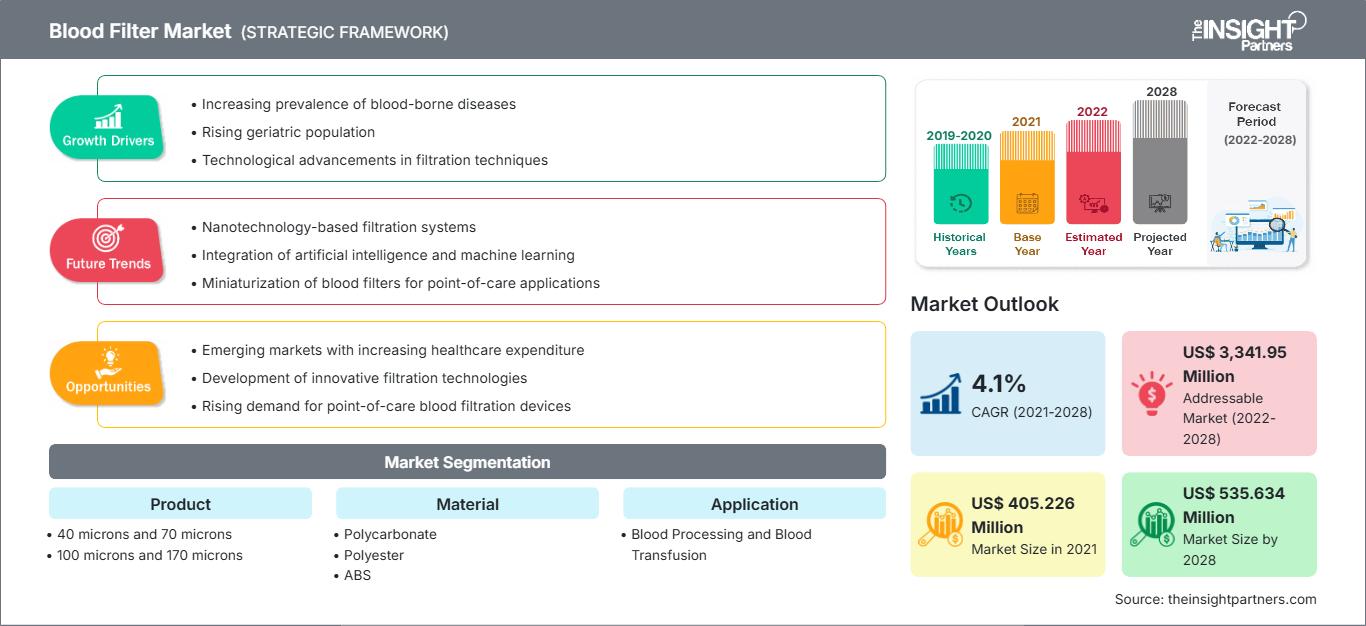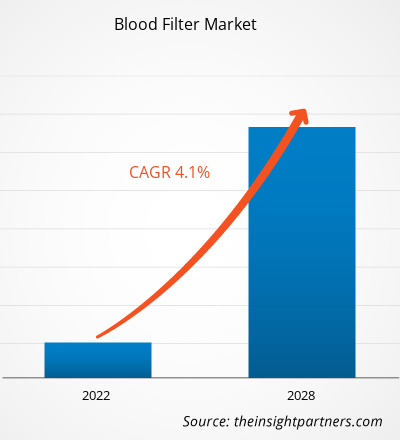Si prevede che il mercato dei filtri per il sangue raggiungerà i 535,634 milioni di dollari entro il 2028, rispetto ai 405,226 milioni di dollari del 2021; si stima una crescita a un CAGR del 4,1% dal 2021 al 2028.
Un filtro per il sangue è un filtro a rete composto da una rete intrecciata in poliestere o nylon, che viene posizionato tra la sacca del prodotto e il paziente per eseguire la filtrazione. Questi filtri sono progettati per proteggere i pazienti da macroaggregati e particolato non ematico che potrebbero essere pericolosi se entrassero nel flusso sanguigno. Rimuovono macroaggregati come siti di microaggregazione e aggregati di fibrina durante una trasfusione di sangue. La filtrazione consiste nel catturare particelle e macroaggregati di leucociti, fibrina e piastrine, formatisi durante la conservazione del sangue. Fattori come l'aumento dell'incidenza delle malattie croniche, l'aumento dei casi di traumi e incidenti e l'aumento del numero di procedure di trasfusione di sangue guidano la crescita del mercato dei filtri per il sangue. Tuttavia, i richiami di prodotto ostacolano la crescita del mercato.
Personalizza questo rapporto in base alle tue esigenze
Potrai personalizzare gratuitamente qualsiasi rapporto, comprese parti di questo rapporto, o analisi a livello di paese, pacchetto dati Excel, oltre a usufruire di grandi offerte e sconti per start-up e università
Mercato dei filtri per il sangue: Approfondimenti strategici

-
Ottieni le principali tendenze chiave del mercato di questo rapporto.Questo campione GRATUITO includerà l'analisi dei dati, che vanno dalle tendenze di mercato alle stime e alle previsioni.
Approfondimenti di mercato
L'aumento del numero di procedure di trasfusione di sangue sostiene la crescita del mercato dei filtri per il sangue
Migliorare la disponibilità di sangue sicuro e adeguato per le procedure di trasfusione dovrebbe essere parte integrante della politica sanitaria nazionale e delle infrastrutture di ogni Paese. La necessità di trasfusioni di sangue può presentarsi in qualsiasi momento nelle aree urbane e rurali. In passato, la mancanza di sangue ha causato la morte di molti pazienti affetti da problemi di salute. Un approvvigionamento adeguato e affidabile di sangue sicuro può essere garantito da strutture stabili per donatori di sangue regolari, volontari e non retribuiti. Rappresentano anche il gruppo di donatori più sicuro, poiché la prevalenza di infezioni trasmesse per via ematica è la più bassa tra questi donatori.
Gli interventi chirurgici più comuni che richiedono trasfusioni di sangue includono procedure cardiovascolari, cesarei e lesioni. Secondo le stime del National Heart, Lung and Blood Institute e dei National Institutes of Health (NIH), negli Stati Uniti oltre 5 milioni di persone necessitano di trasfusioni di sangue ogni anno. Inoltre, a causa di calamità naturali e di cause di morte diffuse, la domanda di trasfusioni di sangue è in aumento in tutto il mondo. Un aumento dell'incidenza di malattie del sangue come anemia, eritrocitosi, leucocitosi, leucopenia e trombocitosi sta inoltre stimolando la crescita del mercato dei filtri per il sangue. Secondo l'OMS, la maggior parte dei bambini con talassemia nasce in paesi a basso reddito, dove l'accesso alle trasfusioni di sangue è difficile o disponibile solo a una piccola percentuale della popolazione.
I filtri per il sangue utilizzati nelle procedure trasfusionali sono costituiti da una rete intrecciata in poliestere o nylon; si tratta di filtri a rete posizionati tra la sacca del prodotto e il paziente. Questi filtri sono progettati per proteggere i pazienti da macroaggregati potenzialmente dannosi come piastrine, leucociti e proteine della fibrina, nonché da particolato non ematico. Nella maggior parte dei paesi sviluppati, i filtri per le trasfusioni di sangue sono forniti dai governi o da programmi basati sulla comunità. Pertanto, la disponibilità di strutture adeguate per la donazione del sangue e la donazione volontaria determinano il numero di procedure trasfusionali, con conseguente incremento della crescita del mercato dei riempitivi per il sangue.
Approfondimenti basati sul prodotto
In base al prodotto, il mercato dei filtri per il sangue è ulteriormente segmentato in 40 micron e 70 micron, 100 micron e 170 micron e altri. Il segmento da 100 micron e 170 micron deterrà la quota di mercato maggiore nel 2021 e si prevede che registrerà un CAGR più elevato durante il periodo di previsione.
Approfondimenti basati sui materiali
In base al materiale, il mercato dei filtri per il sangue è segmentato in policarbonato, poliestere, ABS e altri. Il segmento del poliestere deterrà la quota di mercato maggiore, pari al 35,47%, nel 2021 e si prevede che manterrà la sua posizione dominante durante il periodo di previsione.
Approfondimenti basati sulle applicazioni
In base all'applicazione, il mercato dei filtri per il sangue è segmentato in trattamento del sangue e trasfusione di sangue. Il segmento delle trasfusioni di sangue deterrà la quota di mercato maggiore, pari al 73,83%, nel 2021 e si prevede che manterrà la sua posizione dominante durante il periodo di previsione.
Approfondimenti basati sull'utente finale
In base all'utente finale, il mercato dei filtri per il sangue è segmentato in banche del sangue, ospedali e altri. Il segmento delle banche del sangue deterrà la quota di mercato maggiore, pari al 47,38%, nel 2021 e si prevede che manterrà la sua posizione dominante durante il periodo di previsione.
Diverse aziende che operano nel mercato dei filtri per il sangue stanno adottando strategie quali lanci di prodotti, fusioni e acquisizioni, collaborazioni, innovazioni di prodotto ed espansioni del portafoglio prodotti per espandere la propria presenza in tutto il mondo, mantenere il marchio e soddisfare la crescente domanda degli utenti finali.
Mercato dei filtri per il sangueLe tendenze regionali e i fattori che influenzano il mercato dei filtri per il sangue durante il periodo di previsione sono stati ampiamente spiegati dagli analisti di The Insight Partners. Questa sezione illustra anche i segmenti e la geografia del mercato dei filtri per il sangue in Nord America, Europa, Asia-Pacifico, Medio Oriente e Africa, America Meridionale e Centrale.
Ambito del rapporto sul mercato dei filtri per il sangue
| Attributo del rapporto | Dettagli |
|---|---|
| Dimensioni del mercato in 2021 | US$ 405.226 Million |
| Dimensioni del mercato per 2028 | US$ 535.634 Million |
| CAGR globale (2021 - 2028) | 4.1% |
| Dati storici | 2019-2020 |
| Periodo di previsione | 2022-2028 |
| Segmenti coperti |
By Prodotto
|
| Regioni e paesi coperti |
Nord America
|
| Leader di mercato e profili aziendali chiave |
|
Densità degli operatori del mercato dei filtri per il sangue: comprendere il suo impatto sulle dinamiche aziendali
Il mercato dei filtri per il sangue è in rapida crescita, trainato dalla crescente domanda da parte degli utenti finali, dovuta a fattori quali l'evoluzione delle preferenze dei consumatori, i progressi tecnologici e una maggiore consapevolezza dei benefici del prodotto. Con l'aumento della domanda, le aziende stanno ampliando la propria offerta, innovando per soddisfare le esigenze dei consumatori e sfruttando le tendenze emergenti, alimentando ulteriormente la crescita del mercato.

- Ottieni il Mercato dei filtri per il sangue Panoramica dei principali attori chiave
Mercato dei filtri per il sangue - per prodotto
- 40 micron e 70 micron
- 100 micron e 170 micron
- Altri
Mercato dei filtri per il sangue - per materiale
- Policarbonato
- Poliestere
- ABS
- Altri
Mercato dei filtri per il sangue - per applicazione
- Elaborazione del sangue
- Trasfusione di sangue
Mercato dei filtri per il sangue - per utente finale
- Banche del sangue
- Ospedali
- Altro
Mercato dei filtri sanguigni - per area geografica
- Nord America
- Stati Uniti
- Canada
- Messico
- Europa
- Francia
- Germania
- Italia
- Regno Unito
- Spagna
- Resto d'Europa
- Asia Pacifico (APAC)
- Cina
- India
- Corea del Sud
- Giappone
- Australia
- Resto dell'Asia Pacifico
- Medio Oriente e Asia. Africa (MEA)
- Sudafrica
- Arabia Saudita
- Emirati Arabi Uniti
- Resto del Medio Oriente e Africa
- America meridionale e centrale (SCAM)
- Brasile
- Argentina
- Resto dell'America meridionale e centrale
Profili aziendali
- Asahi Kasei Corporation
- Fresenius Kabi AG
- Macopharma
- Haemonetics Corporation
- Infomed SA
- KANEKA CORPORATION
- Kawasumi laboratories. Inc.
- Sefar AG
- Shandong Zhongbaokang Medical Implements Co., Ltd.
- Nanjing Shuangwei Biotechnology Co., Ltd.
- Analisi storica (2 anni), anno base, previsione (7 anni) con CAGR
- Analisi PEST e SWOT
- Valore/volume delle dimensioni del mercato - Globale, Regionale, Nazionale
- Industria e panorama competitivo
- Set di dati Excel
Report recenti
Rapporti correlati
Testimonianze
Motivo dell'acquisto
- Processo decisionale informato
- Comprensione delle dinamiche di mercato
- Analisi competitiva
- Analisi dei clienti
- Previsioni di mercato
- Mitigazione del rischio
- Pianificazione strategica
- Giustificazione degli investimenti
- Identificazione dei mercati emergenti
- Miglioramento delle strategie di marketing
- Aumento dell'efficienza operativa
- Allineamento alle tendenze normative






















 Ottieni un campione gratuito per - Mercato dei filtri per il sangue
Ottieni un campione gratuito per - Mercato dei filtri per il sangue